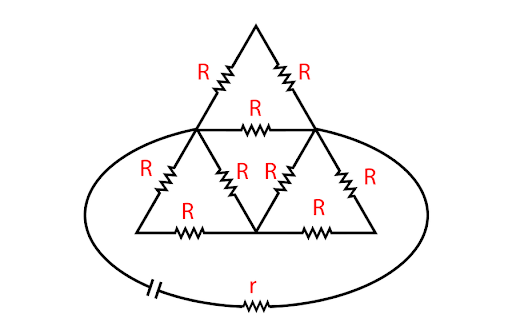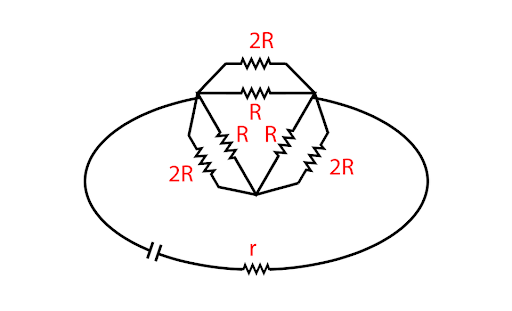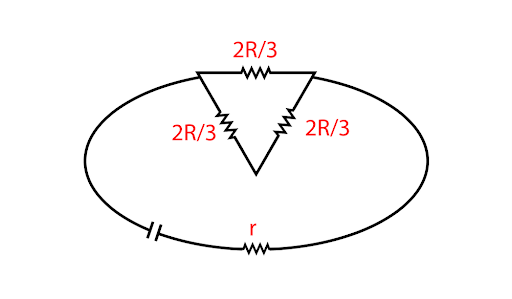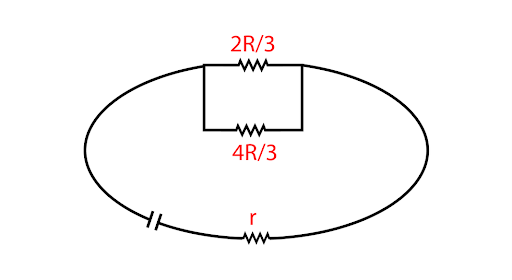
For maximum power from the battery the internal resistance of the battery $r$ is?

A. 10R
B. 4R/9
C. R/8
D. 10R/9
Answer
217.2k+ views
Hint:The numerical problem is from the current electricity part of physics. We can apply electric power and equivalent resistance concepts to solve the problem.
Formula used:
For maximum power, the equivalent resistance should be equal to internal resistance. That is,
$r = {R_E}$
Where ${R_E}$ = equivalent resistant and r = internal resistance.
Equivalent resistance for a series resistance circuit:
${R_E} = {R_1} + {R_2} + {R_3}$
Where ${R_E}$= equivalent resistance and ${R_1},{R_2},{R_3}$ = component resistance.
Equivalent resistance for a parallel resistance circuit:
$\dfrac{1}{{{R_E}}} = \dfrac{1}{{{R_1}}} + \dfrac{1}{{{R_2}}} + \dfrac{1}{{{R_3}}}$
Where ${R_E}$= equivalent resistance and ${R_1},{R_2},{R_3}$ = component resistance.
Complete step by step solution:
In the triangle part of the circuit, the three sides have two resistances in a series connection. Their equivalent resistance will be ${R_E} = R + R = 2R$. The circuit diagram will be

The equivalent resistance for the three parallel combinations in the circuit will become,
$\dfrac{1}{{{R_E}}} = \dfrac{1}{R} + \dfrac{1}{{2R}} = \dfrac{3}{{2R}} \\
\Rightarrow {R_E} = \dfrac{{2R}}{3}$

The equivalent resistance for the three-series connection is,
${R_E} = \dfrac{{2R}}{3} + \dfrac{{2R}}{3} = \dfrac{{4R}}{3}$

The equivalent resistance for the final parallel connection is,
${R_E} = \dfrac{{\dfrac{{2R}}{3} \times \dfrac{{4R}}{3}}}{{\dfrac{{2R}}{3} + \dfrac{{4R}}{3}}} = \dfrac{{4R}}{9}$
Hence, the correct option is option B.
Additional Information: Resistance blocks the flow of current. The S.I. unit of resistance is ohms. The current decreases as resistance increases. On the other hand, the current increases as the resistance decreases. A conductor's electrical resistance is affected by the following parameters: The conductor's cross-sectional area, the conductor's length, the conductor's material and the conducting material's temperature. Electrical resistance is inversely proportional to the cross-sectional area and directly proportional to the conductor's length.
Note: The rate of electrical energy transfer over an electric circuit per unit of time is measured as electric power. The S.I. unit of power is watt or joule per second. The quantity of electric power is scalar.
Formula used:
For maximum power, the equivalent resistance should be equal to internal resistance. That is,
$r = {R_E}$
Where ${R_E}$ = equivalent resistant and r = internal resistance.
Equivalent resistance for a series resistance circuit:
${R_E} = {R_1} + {R_2} + {R_3}$
Where ${R_E}$= equivalent resistance and ${R_1},{R_2},{R_3}$ = component resistance.
Equivalent resistance for a parallel resistance circuit:
$\dfrac{1}{{{R_E}}} = \dfrac{1}{{{R_1}}} + \dfrac{1}{{{R_2}}} + \dfrac{1}{{{R_3}}}$
Where ${R_E}$= equivalent resistance and ${R_1},{R_2},{R_3}$ = component resistance.
Complete step by step solution:
In the triangle part of the circuit, the three sides have two resistances in a series connection. Their equivalent resistance will be ${R_E} = R + R = 2R$. The circuit diagram will be

The equivalent resistance for the three parallel combinations in the circuit will become,
$\dfrac{1}{{{R_E}}} = \dfrac{1}{R} + \dfrac{1}{{2R}} = \dfrac{3}{{2R}} \\
\Rightarrow {R_E} = \dfrac{{2R}}{3}$

The equivalent resistance for the three-series connection is,
${R_E} = \dfrac{{2R}}{3} + \dfrac{{2R}}{3} = \dfrac{{4R}}{3}$

The equivalent resistance for the final parallel connection is,
${R_E} = \dfrac{{\dfrac{{2R}}{3} \times \dfrac{{4R}}{3}}}{{\dfrac{{2R}}{3} + \dfrac{{4R}}{3}}} = \dfrac{{4R}}{9}$
Hence, the correct option is option B.
Additional Information: Resistance blocks the flow of current. The S.I. unit of resistance is ohms. The current decreases as resistance increases. On the other hand, the current increases as the resistance decreases. A conductor's electrical resistance is affected by the following parameters: The conductor's cross-sectional area, the conductor's length, the conductor's material and the conducting material's temperature. Electrical resistance is inversely proportional to the cross-sectional area and directly proportional to the conductor's length.
Note: The rate of electrical energy transfer over an electric circuit per unit of time is measured as electric power. The S.I. unit of power is watt or joule per second. The quantity of electric power is scalar.
Recently Updated Pages
Electrostatic Potential and Capacitance Explained

EMF and Internal Resistance of a Cell: Definitions & Formula

Entropy in Thermodynamic Processes: Explained Simply

Equivalent Capacitance Explained: Formulas, Series & Parallel

Excess Pressure Inside a Liquid Drop Explained

Fluid Pressure Explained: Definition, Formula & Examples

Trending doubts
JEE Main 2026: Application Form Open, Exam Dates, Syllabus, Eligibility & Question Papers

Derivation of Equation of Trajectory Explained for Students

Hybridisation in Chemistry – Concept, Types & Applications

Understanding the Angle of Deviation in a Prism

Understanding Collisions: Types and Examples for Students

How to Convert a Galvanometer into an Ammeter or Voltmeter

Other Pages
JEE Advanced Marks vs Ranks 2025: Understanding Category-wise Qualifying Marks and Previous Year Cut-offs

Understanding Atomic Structure for Beginners

Ideal and Non-Ideal Solutions Explained for Class 12 Chemistry

Degree of Dissociation: Meaning, Formula, Calculation & Uses

Understanding Electromagnetic Waves and Their Importance

Understanding the Electric Field of a Uniformly Charged Ring




